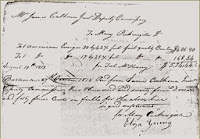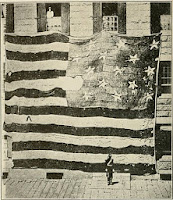We learn the history of the flag when we attend school, and our family is amused over a story involving my daughter when she was in the first or second grade at school. She was taught that Betsy Ross had sewn the flag. During Christmas holidays, when Aunt Bessie was with us, my daughter asked her about sewing the flag. My daughter thought the teacher had been talking about our aunt, whose name was Bessie Ross.
Family genealogy whets my interest in American history and I recently watched an episode about the War of 1812 on television's History channel.
The War of 1812, was our second war of Independence. The visual representation of British forces, 5000 soldiers and a fleet of 19 ships attacking Baltimore on September 12, 1814 showed how desperate and dire the situation was for those defending the fort. The British had already burned the White House and readied to take Baltimore.
The commander of Fort McHenry was Major Armistead who prepared for battle by saying he wanted a Garrison flag ”large enough the British would not have difficulty seeing it from a distance” and a smaller Storm Flag. A flag maker in Baltimore, Mary Young Pickersgill, was commissioned.
In early summer 1813, she began the job with the assistance of her daughter, Caroline, her two nieces, Eliza Young and Margaret Young, a free African American apprentice, Grace Wisher, and likely her elderly mother, Rebecca Young.An additional unnamed African American who boarded in the house is also listed as helping in some sources, as were additional local seamstresses who were hired during the summer.
She made 2 flags; a large flag 30 by 42 feet and a smaller flag 17 by 25 feet. She was paid $405.90 for the large flag and $168.54 for the smaller one, totaling $574.44 on October 27, 1813.
 |
| Receipt for the Flag |
The flag, a combination of cotton and wool bunting in red and white with 15 stars and 15 stripes. Each stripe was 2 feet wide and each star measured 2 feet in diameter. The stars oriented in alternating columns horizontally which was the practice at the time rather than vertically like today. The staggered row pattern was common for Naval flags until Congress standardized the design in 1818.
Bombardment of Fort McHenry began on September 13, 1814 and raged continuously for 27 hours. The shelling was constant, even throughout a heavy rain storm. Some eight miles distant, an American lawyer was held prisoner by the British on board a truce ship in the Patapsco River. As he watched the battle from afar, aware that loss of the fort would mean swearing allegiance to England, he anxiously observed the flashes of bursting bombs all during the night.
When dawn came the morning of the 14th, he saw the Garrison flag still flying, and was so moved he wrote the first few lines of a poem. He put them in his pocket to finish some time later. The Lawyer was Francis Scott Key and the poem, which became our National Anthem, was about our first Star Spangled Banner.
 |
| Fort McHenry Flag |

No comments:
Post a Comment